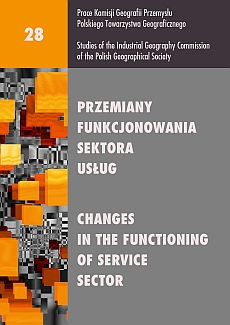Localization policy of selected hotel systems in Cuba under the economic crisis conditions
DOI:
https://doi.org/10.24917/20801653.28.1Keywords:
Cuba, location policies, hotel systems, tourismAbstract
Each year the meaning of Cuba on the international tourism services market is increasing, which is visible in the size of tourism development and the amount of foreign tourists visiting the country. It was relatively recently that Cuba emerged as an area of tourist reception; prolonged isolation of the country prompted in the early 1990s the need of undertaking a variety of activities aiming at improving the state of the country’s tourist infrastructure, both qualitatively and quantitatively. The case study analyzes the location policies of chosen hotel systems, both foreign (Sol Melia) and Cuban (Cubanacan, Gaviota). One of the main research issues is presenting the spatial expansion of hotels in comparison with the already existing tourism regions, their natural and cultural specification, as well as the ones yet to be developed. Additionally, the analysis of natural, cultural, infrastructural (availability of transportation), economical, and political conditions for the future investments of the hotel industry is also present. It seems valid to state that the most important factor for the development of tourism, especially in the historical sense, was the political one, stemming from the idea of isolating foreign tourists from local inhabitants, which resulted in the emergence of tourist enclaves. In her research, the author concentrates on the problems of tourism development in the Caribbean region. The dominating research topics are the size and spatial differentiation of tourist infrastructure and tourism volume itself together with the directions of the tourism development. The research topics also include the issue of tourist enclaves as a dominating form of tourist infrastructure in the Caribbean region in light of sustainable development and pro-poor tourism.
Downloads
Metrics
References
Brenner, L. (2005). State-planned tourism destinations: the case of Huatulco, Mexico. Tourism Geographies, vol. 7, 138–164.
Cervino, J., Cubillo, J.M. (2005). Hotel and tourism development in Cuba. Opportunities, management, challenges, and future trends. Cornell Hotel and Restaurant Administration Quarterly, 46(2), 223–246.
Derek, M. (2007). Od wioski rybackiej do turystycznej enklawy? Turystyka a rozwój lokalny na przykładzie Mikołajek. Studia Regionalne i Lokalne, 2(28), 112–127.
Durydiwka, M., Duda-Gromada, K. (2011). Między autentycznością a kreacją – tendencje i przyczyny zmian w przestrzeni turystycznej. Przestrzeń turystyczna. Czynniki, różnorodność, zmiany. Warszawa: Uniwersytet Warszawski, Wydział Geografii i Studiów Regionalnych, 53–63.
Jędrusik, M. (2005). Wyspy tropikalne. W poszukiwaniu dobrobytu. Warszawa: Wydawnictwa Uniwersytetu Warszawskiego.
Kauppila, P. (2010). Resorts and regional development at the local level: a framework for analysing internal and external factors. Nordia Geographical Publications, 39(1), 39–48.
Kowalczyk, A. (1999). Polityka lokalizacyjna wybranych systemów hotelowych. Turyzm, 9(1), Łódź: Uniwersytet Łódzki, 137–159.
Kowalczyk, A. (2001). Geografia hotelarstwa. Łódź: Wydawnictwo Uniwersytetu Łódzkiego.
Lau, G., McKercher, B.(2007). Understanding the Movement Patterns of Tourists in a Destination: A GIS Approach. Tourism and Hospitality Research, 7(1), 39–49.
Lew, A., Mc Kercher, B. (2006). Modeling tourist movement: a local destination analysis. Annals of Tourism Research, 33(2), 403–423.
Matthews, H.G. (1977). Radicals and third world tourism: A caribbean focus. Annals of Tourism Research, 5(1), 20–29.
McKercher, B., Lew A.A. (2004). Tourist flows and the spatial distribution of tourists. W: A.A. Lew, C.M. Hall, A.M. Williams (red.): A companion to tourism. Blackwell, Malden, Oxford and Carlton, 36–48.
Renata Rettinger Núñez, G.G., Fernández, R.O. (2011). Cuba y el turismo norteamericano. Analisis de potencialidades y de impactos en la región caribeña. Cuba Futures Series, 141–199.
Oppermann, M. (1995). A model for travel itineraries. Journal of Travel Research, 33, 57–61.
Pérez-López, J.F. (1995). Cuba’s Second Economy: From Behind the Scenes to Center Stage. New Brunswick, NJ: Transaction Books.
Pérez-López, J.F. (2001). Cuba’s Socialist Economy: the Mid-1990s. W: I.L. Horowitz, J. Suchlicki, (red.). Cuban Communism. 10. wyd. New Brunswick: Transaction Publishers, 205–236.
Sheller, M. (2004). Natural Hedonism: The Invention of Caribbean Islands as Tropical Playgrounds. W: S. Courtman (red.) Beyond the Blood, the Beach and the Banana: New Perspectives in Caribbean Studies. Kingston: Ian Randle.
Stewart, S.I., Vogt, C.A. (1997). Multi-destination trip patterns. Annals of Tourism Research, 24, 458–461.
Whittle D.J., Lindeman K.C., Tripp J.T.B. (2003). International Tourism and Protection of Cuba’s Coastal and Marine Environments. Tulane Environmental Law Journal, 16, 1–57.
Downloads
Published
How to Cite
Issue
Section
License
Articles are published under the terms of the Creative Commons License (CC BY-ND 4.0; Attribution– NoDerivs).

